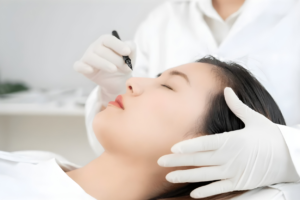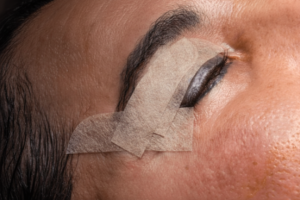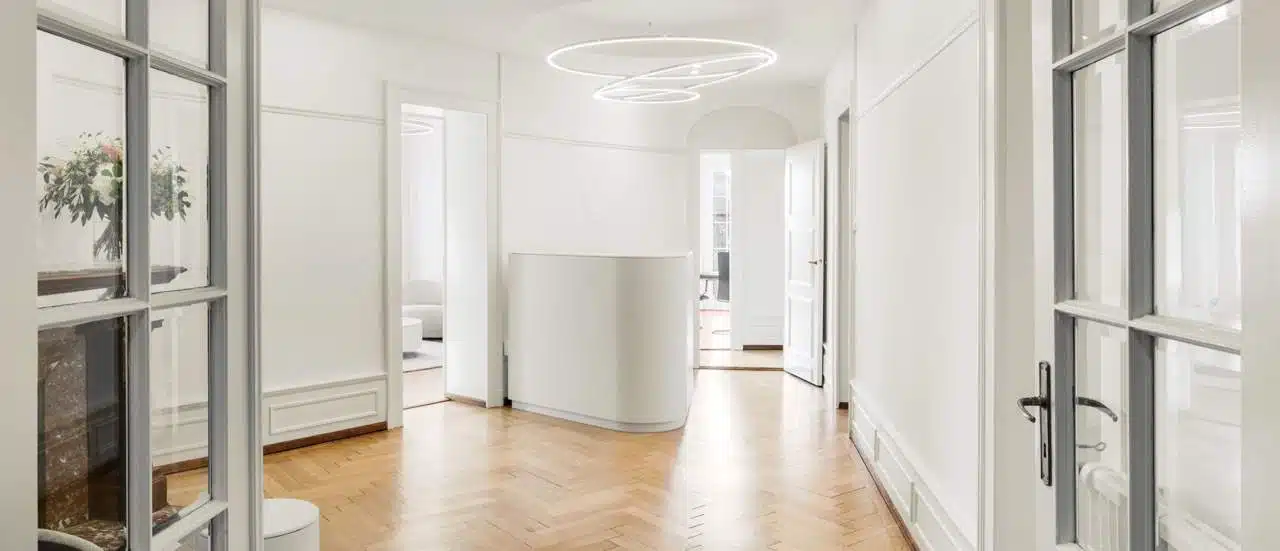How is the procedure performed?
In general, most procedures on the upper eyelids (also called “upper blepharoplasty”) are performed under local anaesthetic and are perfectly tolerable. The procedure lasts between 45 and 60 minutes. One hour before the procedure, a thick layer of anaesthetic cream such as Anesderm 5% is applied. The cream will reduce any pain when the local anaesthetic is injected with a syringe. Once the local anaesthetic has been injected, it will numb the eyelid and you will not feel any pain during the procedure (and this is definitely the case!).
For lower blepharoplasty, we generally perform the procedure under deep sedation or general anaesthetic. This is because lower blepharoplasty is a little more sensitive than upper blepharoplasty, as the patient must keep their eyes partially open during the procedure.
Before your eyelid surgery
Before your procedure, there are generally no specific tests to be done: you do not need to have a blood test or a preoperative check-up with an ophthalmologist. If the procedure is performed under deep sedation or general anaesthesia, our anaesthetist will call you one month before the procedure. You can eat and drink on the day of the procedure if local anaesthesia is used. If you have opted for sedation or general anaesthesia, you must follow the fasting instructions given by the anaesthetist. You can take all your usual medication on the day of the procedure, unless otherwise advised by Dr. Favre.
We often recommend taking arnica capsules for 3 days before the procedure and 7 days after the procedure. Please do not drive to the Bellefontaine Clinic, as your vision may be temporarily blurred after the procedure. Bring sunglasses with you to hide the bandages when you leave the clinic. We also advise you to purchase NaCl eye drops and a cold pack suitable for the eyelids in advance. All this information will be provided to you before your procedure.
Essential guidelines for a successful recovery after your blepharoplasty
Immediately after the procedure, we will apply a cold pack to your eyelids for 45 minutes. This reduces inflammation and the risk of bleeding. There is often very slight bleeding around the edges of the dressing. This usually subsides after a few hours. During this time, we will provide you with some compresses to dab away any drops.
You can then follow these tips to take care of yourself at home after your operation.
- Wear dark sunglasses on your way home. This will hide your procedure from other people. You may also be sensitive to light.
- Use the cold pack for the first 48 hours after the procedure. Place a compress or cloth between the cold pack and your skin. Do not apply the cold pack directly to the skin, as this may cause skin damage.
- The wound may be slightly painful, but should not be extremely painful. We recommend taking Dafalgan as needed for the first 2 days.
- It is common to experience dry eyes immediately after the procedure. Sometimes vitamin A ointment is also used at the end of the procedure. The ointment used during your surgery and dry eyes may cause blurred vision. This is temporary and usually disappears within 24 hours. If your eyes remain dry, you can use the eye drops described above. Apply the eye drops every 4 hours inside the eye.
- We advise against driving for the first 4 to 5 days after the procedure until the symptoms have completely disappeared. Make sure you can drive safely and comfortably.
- If you can wear glasses, wear them for the first two weeks after the procedure. You can then put in your contact lenses if you wear them.
- Avoid reading or looking at screens for the first 48 hours.
- It is important to rest for the first 2 days after your operation. Avoid activities such as lifting heavy objects and exercising. When putting on your shoes, avoid bending your head completely downwards.
- Sleep with your head elevated for the first 2 nights after the procedure.
- Your eyelids will be swollen for 7 to 12 days. You can expect the swelling to increase during the first three days before it begins to subside. The intensity of bruising varies greatly from person to person. Over time, the swelling and bruising will gradually move from your eyelids to your jaw.
- Take arnica for 3 days before and 7 days after the procedure.
Showering and make-up
You can shower from the neck down the day after the procedure. Do not wet your eyelids for 14 days. You can gently wash under your eyes with wipes or a soft washcloth. Do not remove the dressing, as you may remove the stitches used during the procedure. To wash your hair, we recommend tilting your head back and having someone else or your hairdresser shampoo your hair.
Do not apply any creams or make-up to the operated areas for two weeks after the procedure. However, you may use creams and make-up on the rest of your face.
Returning to work
For office work, you can generally return to work two days after the procedure. For more physical work, it is necessary to wait two weeks.
What are the risks after blepharoplasty?
Blepharoplasty is a procedure with a very low risk of post-operative complications. However, here are some signs to look out for:
- Uncontrollable bleeding
- Open wound.
- Red, hot and painful eyelid.
- Loss of vision unrelated to the application of the eye ointment.
- Intense pain that cannot be relieved by Dafalgan.
These risks are very rare and should not cause you undue concern about undergoing this procedure. Blepharoplasty has an extremely high post-operative satisfaction rate and leaves only a very discreet scar.



